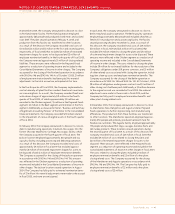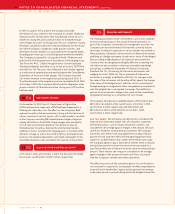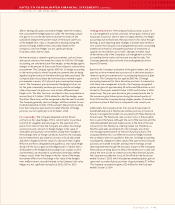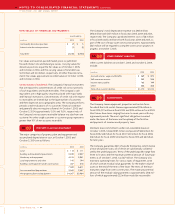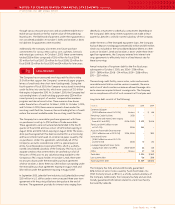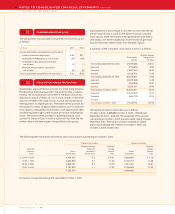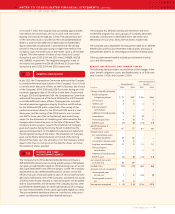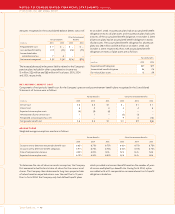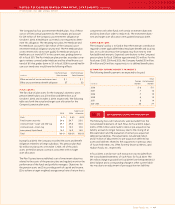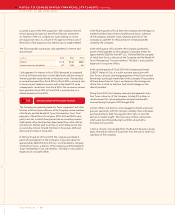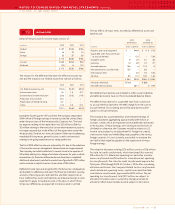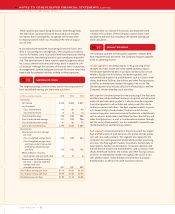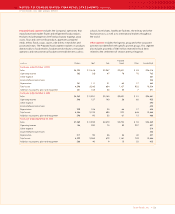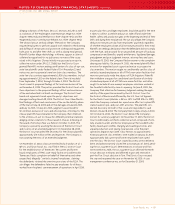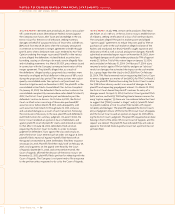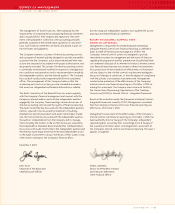Tyson Foods 2005 Annual Report Download - page 53
Download and view the complete annual report
Please find page 53 of the 2005 Tyson Foods annual report below. You can navigate through the pages in the report by either clicking on the pages listed below, or by using the keyword search tool below to find specific information within the annual report.
>> NOTES TO CONSOLIDATED FINANCIAL STATEMENTS (CONTINUED)
TYSON FOODS, INC. 2005 ANNUAL REPORT
>>>>>>>>>>>>>>>>
>>>>>>>>>>>>>>>>
Tyson Foods, Inc. >> 51
INCOME TAXES
>> 17
Detail of the provision for income taxes consists of:
in millions 2005 2004 2003
Federal $137 $183 $156
State 16 12 10
Foreign 22 37 20
$175 $232 $186
Current $249 $224 $73
Deferred (74) 8 113
$175 $232 $186
The reasons for the difference between the effective income tax
rate and the statutory U.S. federal income tax rate are as follows:
2005 2004 2003
U.S. federal income tax rate 35.0% 35.0% 35.0%
State income taxes 1.8 1.8 2.2
Extraterritorial income exclusion (2.6) (0.5) (1.9)
Reduction of tax reserves (4.1) – –
Repatriation of foreign earnings 4.2 – –
Other (1.2) 0.3 0.2
33.1% 36.6% 35.5%
During the fourth quarter of fiscal 2005, the Company repatriated
$404 million of foreign earnings invested outside the United States
under the provisions of the American Jobs Creations Act. The total
tax expense relating to the repatriation was $22 million, offset by
$15 million relating to the reversal of certain international tax reserves
no longer required due to the effects of the repatriation under the
American Jobs Creation Act. Items included in Other are miscellaneous
nondeductible expenses, general business credits and amounts
relating to on-going examinations by taxing authorities.
The fiscal 2005 effective rate was reduced by 4.1% due to the reduction
of income tax reserves management deemed were no longer required.
The Company recorded a reduction to current income tax expense of
$22 million relating to a change of estimate of reserves for years in which
examinations by the Internal Revenue Service have been completed.
Additional adjustments resulted in a reduction of goodwill of $27 million
and an increase in capital in excess of par value of $25 million.
Deferred income taxes are recognized for the future tax consequences
attributable to differences between the financial statement carrying
amounts of existing assets and liabilities and their respective tax
basis. Deferred tax assets and liabilities are measured using tax rates
expected to apply to taxable income in the years in which those
temporary differences are expected to be recovered or settled.
The tax effects of major items recorded as deferred tax assets and
liabilities are:
2005 2004
Deferred Tax Deferred Tax
in millions Assets Liabilities Assets Liabilities
Property, plant and equipment $ – $489 $ 4 $ 513
Suspended taxes from conversion
to accrual method – 125 – 138
Intangible assets 9253124
Inventory 10 89 12 77
Accrued expenses 108 6 114 4
Net operating loss carryforwards 123 – 83 –
International items –6518104
All other 90 110 103 148
$ 340 $909 $365 $1,008
Valuation allowance $(102) $ (66)
Net deferred tax liability $671 $ 709
Net deferred tax liabilities are included in other current liabilities
and deferred income taxes on the Consolidated Balance Sheets.
The deferred tax liability for suspended taxes from conversion
to accrual method represents the 1987 change from the cash to
accrual method of accounting and will be paid down by 2017,
subject to certain limitations.
The Company has accumulated but undistributed earnings of
foreign subsidiaries aggregating approximately $161 million at
October 1, 2005, which are expected to be indefinitely reinvested
in the business. If those earnings were distributed in the form of
dividends or otherwise, the Company would be subject to U.S.
income taxes (subject to an adjustment for foreign tax credits),
state income taxes and withholding taxes payable to the various
foreign countries. It is not currently practicable to estimate the
tax liability that might be payable on the repatriation of these
foreign earnings.
The valuation allowance totaling $102 million consists of $16 million
for state tax credit carryforwards, which have been fully reserved,
$78 million for U.S. federal net operating loss and other miscella-
neous carryforwards and $8 million for international net operating
loss carryforwards. The state tax credit carryforwards expire in the
fiscal years 2006 through 2009. At October 1, 2005, after considering
utilization restrictions, the Company’s federal tax loss carryforwards,
which include net operating losses, capital losses and charitable
contribution carryforwards, approximated $241 million. The net
operating loss carryforwards total $217 million, are subject to
utilization limitations due to ownership changes and may be
utilized to offset future taxable income subject to limitations.


